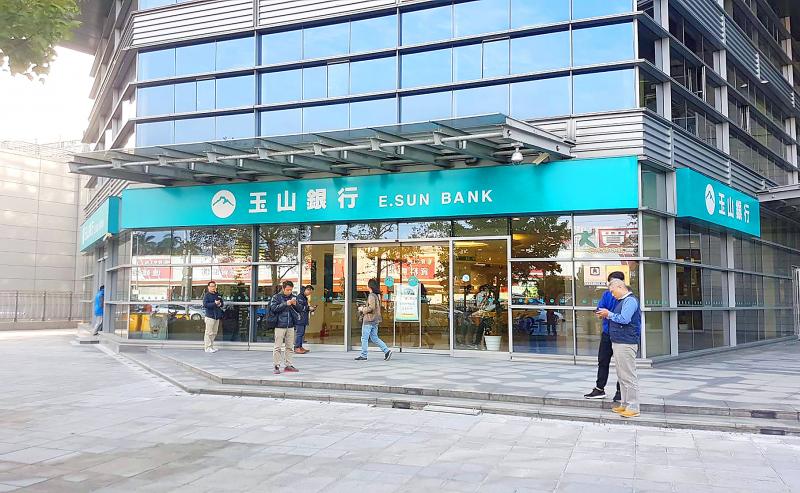E.Sun Commercial Bank (玉山銀行) and Hua Nan Commercial Bank (華南銀行) on Tuesday said that they would make all of their branches bilingual by 2026, with their employees proficient in English.
E.Sun Financial Holding Co (玉山金控) wholly owns E.Sun Bank, which has 139 branches in Taiwan, while Hua Nan Financial Holding Co (華南金控) owns Hua Nan Bank, which has 186 branches.
Since last year, the Financial Supervisory Commission (FSC) has been pushing local banks to become bilingual in a bid to boost the competitiveness of the banking sector.

Photo: CNA
The commission has said that 15 banks in Taiwan have made 69 branches bilingual.
E.Sun Financial president Magi Chen (陳美滿) said that the bank so far has 17 bilingual branches.
One of its bilingual branches is in Kaohsiung’s Zuoying District (左營), close to the Taiwan High Speed Rail’s Zuoying Station, an area with a major department store and an American school, Chen said, adding that the branch has recorded a bank record for the number of foreign-exchange transactions and new accounts opened by foreign clients.
Next year, E.Sun Bank is to model 13 more branches on the Zuoying branch to achieve its 2026 goal, Chen said.
E.Sun Bank said that with 28 outlets in nine foreign markets, it has 2,663 employees who possess foreign-language proficiency certificates.
Hua Nan Bank, which has 11 bilingual branches in Taiwan, expects to increase that number to 100 over the next two years to reach its 2026 goal, Hua Nan Financial chairman Derek Chang (張雲鵬) said.
Hua Nan Bank has also installed the first artificial intelligence clerk in Taiwan, which can communicate in English with foreign clients, Chang said, adding that it can also provide services outside business hours.
Hua Nan Bank is forming a bilingual seed team that can train employees in central, southern and eastern Taiwan so that they are better positioned in a competitive market, Chang said.

SEMICONDUCTORS: The firm has already completed one fab, which is to begin mass producing 2-nanomater chips next year, while two others are under construction Taiwan Semiconductor Manufacturing Co (TSMC, 台積電), the world’s largest contract chipmaker, plans to begin construction of its fourth and fifth wafer fabs in Kaohsiung next year, targeting the development of high-end processes. The two facilities — P4 and P5 — are part of TSMC’s production expansion program, which aims to build five fabs in Kaohsiung. TSMC facility division vice president Arthur Chuang (莊子壽) on Thursday said that the five facilities are expected to create 8,000 jobs. To respond to the fast-changing global semiconductor industry and escalating international competition, TSMC said it has to keep growing by expanding its production footprints. The P4 and P5

DOWNFALL: The Singapore-based oil magnate Lim Oon Kuin was accused of hiding US$800 million in losses and leaving 20 banks with substantial liabilities Former tycoon Lim Oon Kuin (林恩強) has been declared bankrupt in Singapore, following the collapse of his oil trading empire. The name of the founder of Hin Leong Trading Pte Ltd (興隆貿易) and his children Lim Huey Ching (林慧清) and Lim Chee Meng (林志朋) were listed as having been issued a bankruptcy order on Dec. 19, the government gazette showed. The younger Lims were directors at the company. Leow Quek Shiong and Seah Roh Lin of BDO Advisory Pte Ltd are the trustees, according to the gazette. At its peak, Hin Leong traded a range of oil products, made lubricants and operated loading

The growing popularity of Chinese sport utility vehicles and pickup trucks has shaken up Mexico’s luxury car market, hitting sales of traditionally dominant brands such as Mercedes-Benz and BMW. Mexicans are increasingly switching from traditionally dominant sedans to Chinese vehicles due to a combination of comfort, technology and price, industry experts say. It is no small feat in a country home to factories of foreign brands such as Audi and BMW, and where until a few years ago imported Chinese cars were stigmatized, as in other parts of the world. The high-end segment of the market registered a sales drop

Citigroup Inc and Bank of America Corp said they are leaving a global climate-banking group, becoming the latest Wall Street lenders to exit the coalition in the past month. In a statement, Citigroup said while it remains committed to achieving net zero emissions, it is exiting the Net-Zero Banking Alliance (NZBA). Bank of America said separately on Tuesday that it is also leaving NZBA, adding that it would continue to work with clients on reducing greenhouse gas emissions. The banks’ departure from NZBA follows Goldman Sachs Group Inc and Wells Fargo & Co. The largest US financial institutions are under increasing pressure